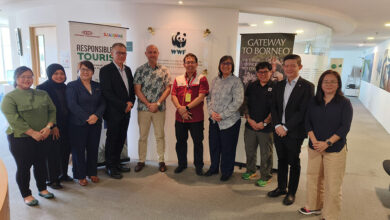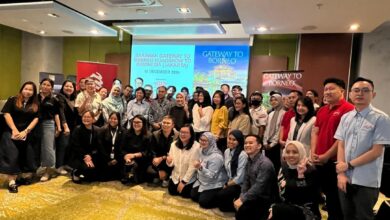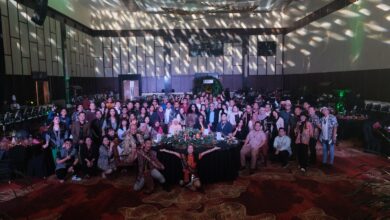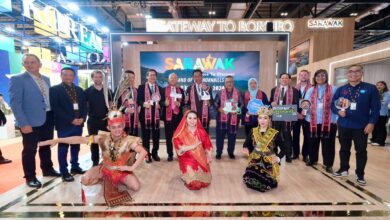Keringkam, The Glittering Crown
Keringkam, The Glittering Crown of Sarawakian Malay Women
Keringkam – shawls and veils made from rubia gauze fabric, fully embroidered with golden or silver coloured course threads – is the elegant traditional headscarf synonymous with Sarawakian Malay women.
With unique designs and motifs which have interesting names such as ‘chicken feet’, mountain, irrigation canals, scissor lace, beans, creeping plants, flowers, orchids and geometric patterns such as crowns, keringkams have also become precious heirlooms for many Sarawakian Malay families that have managed to pass on these treasures from one generation to another.

Interestingly, the word keringkam is not found in the Malay dictionary. In the 2006 The Sarawakiana Series: Malay Culture journal on keringkam, it is believed that the word keringkam is phonetically derived from the French word clinquat which means “glittering, decked with gold”. Another possibility is that keringkam is a combination of two words, namely Keling and Kam. Keling is a reference to Southern Indian merchants who brought the gold threads to trade in Sarawak. Kam may be taken from the ancient Cambodian language which means “types of fabrics”, or it might also have its roots from the Thai word Kham meaning “gold or anything that is beautiful”. Why kelingkam to keringkam? Well, a popular belief is that the change from “l” to “r” is heavily influenced by the Sarawakian Malay dialect that stresses strongly on the pronunciation of the consonant “r”.
There are two types of keringkam: a Selayah (veil) and a Selendang (shawl). A selayah that measures about 55cm wide and 95cm long covers the head right to the shoulder, while a 77cm wide and 156cm long selendang is worn right to the waist level of the wearer. Keringkams are primarily worn by the Malay women during the akad nikah (wedding solemnisation) ceremony, wedding receptions, engagement ceremonies, official functions, and ceremonial visits. Keringkams can also be seen worn by dancers in cultural performances and even at funerals, as the keringkam is usually placed to cover the head of the deceased.


Keringkam embroidery is an extremely intricate and meticulous process. Believe it or not, the technique of keringkam embroidery is a mathematical one – the embroiderer will calculate the strands on the fabric to determine the size of a chosen motif, which will then be repeated to ensure all motifs are identical.
All keringkams are handstitched on a pemidang (a rectangular-shaped table-like frame for the embroiderer to work on) with essential tools such as the lace spindles, silver or bronze flat needles, a pair of scissors and the star of keringkam – the gold threads. A simple piece can take two to three months to complete and the custom-made ones, that cater to the wishes of the wearer to have more motifs sewn in, will take even longer. As the scarves are embroidered with gold threads priced at RM150 a spool, a piece of keringkam can cost several thousand Ringgit, depending on its size and how heavily embroidered it is.


Ranee Margaret Brooke, the wife of the second White Rajah of Sarawak Charles Vyner Brooke who integrated herself with the locals and their culture, fell in love with the style of dress of the Sarawakian Malay women, as she wrote in her memoir My Life in Sarawak published in 1913 – “I thoroughly enjoyed putting on the costume, so comfortable it was, the discarding of my stays, too, those mid-Victorian horrors of steel and whalebone worn by fashionable females of that era. In my cool garb, I felt free, untrammelled, and (greatest of all charms in my eyes) quite Malay!”.
During a webinar sharing on keringkam and songket by Kraftangan Malaysia Development Corporation (Sarawak Branch), it was revealed that not only Ranee Margaret, but almost all of the Brookes embraced the lifestyle, culture and tradition of the Sarawakian Malays. Their appreciation and love for the local fashion was apparent when Ranee Margaret’s daughter-in-law Dayang Muda Gladys Brooke wore full Sarawakian Malay attire (with both keringkam and songket) during a visit to the Vatican City with her husband Tuan Muda Bertram Brooke in 1946.


Ranee Margaret’s affection for keringkam was further shown when she wore the traditional shawl for her official portrait and frequently invited local Malay embroidery craftsman from the nearby kampungs (villages) along the Sarawak River to the Astana (the Brooke’s residence) to produce their crafts and also teach more women to learn to make keringkam. One of them is Ros Alan from Kampung Sinjan who became one of the royal embroiderers to the Brookes in the 1880s.

Today, keringkam is not only limited to veils and shawls, but its use has also diversified and been incorporated into accessories and apparels such as handbags, ladies shoes, wall frame decorations, blouse sleeves and a host of others. Keringkam embroiderers are also entrepreneurs, establishing their own brands to cater to an increasing demand for keringkam and paving the way for a deeper appreciation to the Sarawakian Malay heritage.
For centuries, keringkam has stood the test of time, being the “crown” of elegance and beauty of Sarawakian Malay women. It is not just a head covering, it is a symbol of social status, culture, history, traditions, religion, heritage and more. Thus, the art of keringkam and the skills of keringkam-making must be preserved, expanded and promoted among the youth of today. With a class of its own, it is possible for the keringkam of Sarawak to be elevated to an international level. Who knows, one day we may be able to see keringkam being paraded on the fashion runways of New York and Paris!




